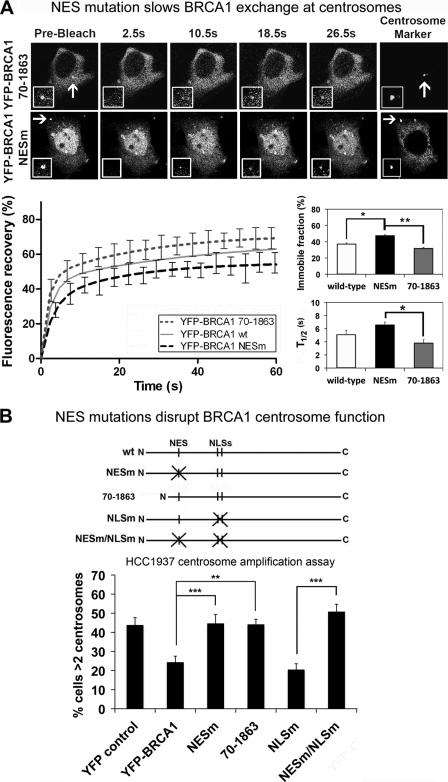FIGURE 6.
NES mutation disrupts BRCA1 dynamics and function at the centrosome. A, FRAP analysis was performed on live MCF-7 cells co-transfected with RFP-pericentrin C241 and YFP-BRCA1 mutants, 70–1863 and NESm, deficient in binding to BARD1 and CRM1, respectively. The 70–1863 sequence is highly export-active (39). Centrosome fluorescence was photobleached, and fluorescence recovery was then measured by time lapse microscopy. Representative prebleach, first image postbleach, and images for 10.5, 18.5, and 26.5 s after bleach are shown for each protein. The insets show higher magnification views of the target area. Corresponding recovery curves are shown for the above proteins, as well as wild-type BRCA1. The t½ (half-time ± S.E. (error bars)) and immobile fractions (percentage ± S.E.) are also shown. Statistical significance of changes in immobile fraction and half-time are indicated. *, p < 0.05; ***, p value < 0.001. B, different BRCA1 mutants defective in binding to BARD1 or in nuclear transport were tested for their ability to regulate centrosomal amplification. YFP-tagged BRCA1 proteins were transfected into HCC1937 breast cancer cells, and cells were then treated with 10 Gy of IR and left to recover for 72 h. Cells were fixed and immunostained with anti-γ-tubulin antibody and analyzed for centrosome amplification (>2 centrosomes/cell). Scoring results are from three independent experiments (mean ± S.D.) and Student's t test was used to determine statistical significance. **, p value < 0.01; ***, p value <0.001.

